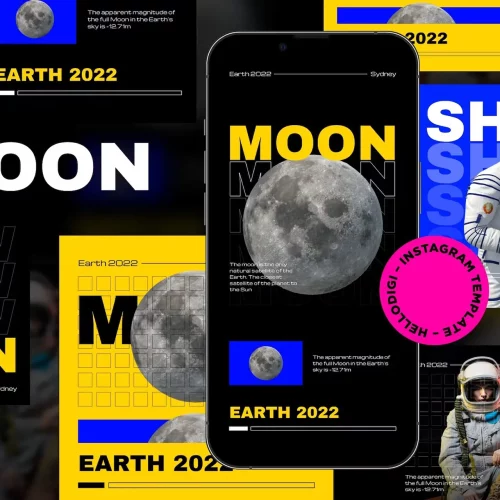The type of person who is quite sensitive to what is labeled “the best”. So to choose the 14 classic marketing campaigns that are going to be listed below is a relatively difficult task.
So why are these marketing campaigns considered classics of the world?
Because of the far-reaching, positive effects it has on the brand, and also because they have touched the emotions that make us forced to remember it over the years. The truth is that sometimes some people aren’t even born when these campaigns start running.
What is a Marketing Campaign?
A marketing campaign is a collection of a variety of different content, built around a specific message. Brands always use many different marketing channels to bring this campaign to people. The time and cost of each Marketing campaign are measured to achieve the highest efficiency with the resources that the business has.
And here, without further ado, note that there aren’t any ratings for these classic campaigns (but feel free to leave a comment on which campaign impressed you the most): 14 Business Marketing Campaigns Dictionary of the World and the lessons hidden behind.
The World’s 14 Classic Marketing Campaigns (And Why It’s Successful)
1) Nike: Just Do It.
Did you know that, once upon a time, Nike products were mostly just for marathon runners? Then there was the sportswear craze—and Nike’s marketing knew it needed action to get ahead of its main competitor, Reebok. (At that time, Reebok sales were many times higher than Nike’s.)
And then, in the late ’80s, Nike launched the campaign that many people must be familiar with “Just Do It.” It created a real sensation.
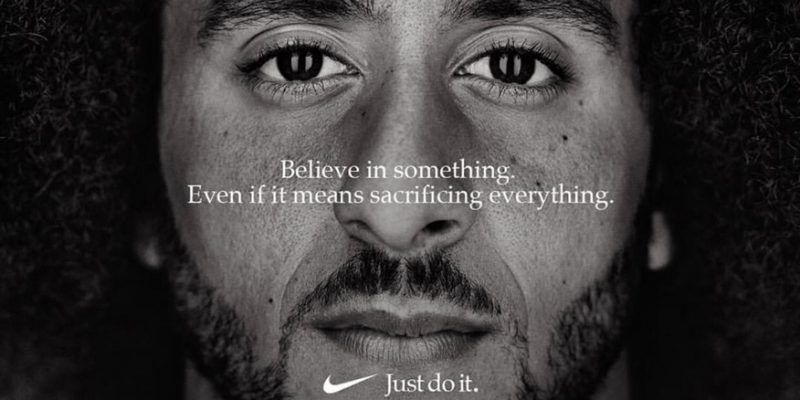
In 1988, Nike sold $800 million; Ten years later, sales were 10 times higher to $9.2 billion. The sentence “Just Do It.” It was brief, yet packed with all the emotions people got when they exercised – and they still feel it to this day.
Don’t want to run 500m? “Just Do It”. Don’t want to cycle 2 laps around the lake? “Just Do It”. It is the slogan we can think of: Keep pushing yourself beyond all limits.
So, when you’re wondering how to represent your brand, ask yourself: What problem are you solving for your customers? What solution is your product or service providing? When you fully and clearly answer those key issues, you’ll come up with ways to connect with your customers that they’ll never forget.
2) Absolut Vodka: The Absolut Bottle
While not having any different shapes, it is Absolut to make their bottles the most recognizable wine bottle in the whole world. This campaign, by linking real-life images to the shape of a wine bottle, was so successful that they didn’t stop running for 25 years.
This is the longest campaign in history with more than 1500 different ads.
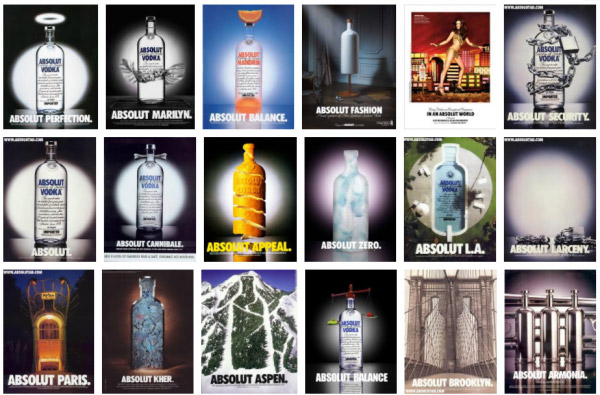
When this campaign started, Absolut had a 2.5% market share in the vodka market. In the late 2000s, Absolut was selling more than 4.5 million cases a year, half the total volume of vodka imported in the United States at the same time.
So what is the marketing lesson here? No matter how boring your product looks, that doesn’t mean you can’t tell its story in the most interesting way. To reiterate: Absolut generates over 1500 ads for just one bottle of wine.
3) Miller Lite: Great Taste, Less Filling
Is creating a whole new market for your product an easy task? Miller Brewing Company (now MillerCoors) did just that by creating the “light beer” market – and dominating it.
The purpose of the “Great Taste, Less Filling” campaign was to get real men to drink “light beer”, but they had to fight intensely with the misconception that “light beer” could not drink anything. What. Miller put the image of a muscular, muscular, “yeast” looking man to drink this product and affirms that it is delicious.
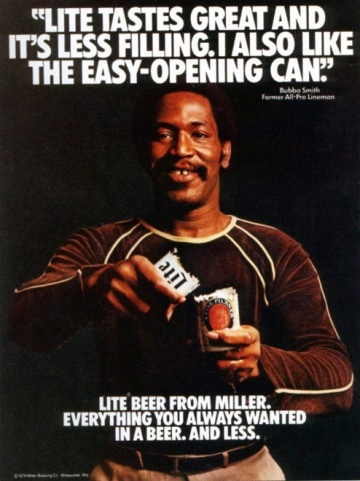
Decades later, Miller Lite still dominates the market they created.
So what is the marketing lesson here? Fight to be different. If people tell you that your product has no chance to live in this market, create your own niche so that you quickly become a leader.
4) Volkswagen: Think Small
Many marketing and advertising experts have rated Volkswagen’s “Think Small” campaign the gold standard. Built in 1960 by the legendary advertising group Doyle Dane & Bernbach (DDB), with the aim to answer one question: How has it changed everyone’s perception of the product?
See, Americans have always had a habit of owning really big, epic cars, and even after 15 years when the second world war ended, most Americans did not buy cars. This petite German.
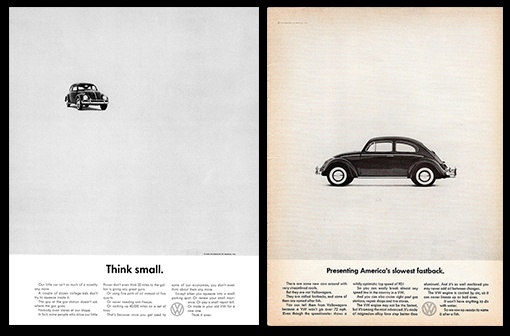
So what did the Volkswagen ad do? “You think I’m small? Yeah, I’m small.” They never try to be something they’re not.
That’s the most important thing we can learn from this marketing campaign: Don’t try to overstate, or worse, lie about your products and services in advertising. Customers always appreciate honesty.
5) Dos Equis: The Most Interesting Man in the World
You may know this man. Smoked Cuban cigars, surrounded by pretty girls and—most importantly—he drank Dos Equis beer.
A pretty good factor to create a successful marketing campaign about wine, beer, luxury products is to make them really “cool”. And then came the slogan “The Most Interesting Man in the World”, instantly making him the most “cool”-looking advertiser.
And to end every commercial he appeared in, there was always a saying: “I don’t always drink beer, but when I do, I prefer Dos Equis. Stay thirsty my friends.” (This sentence would probably be better without translation)
This saying has become an “obsession” with those who have seen the ad and went to buy beer the next time. And although Dos Equis recently replaced the new advertising model, the man will forever live on in the world of memes, in wine bars, and in the minds of customers. by Dos Equis.
6) California Milk Processor Board: Got Milk?
Thanks to the California Milk Processor Board’s “Got Milk?” Marketing campaign, milk sales in California grew 7% in just one year. But its impact went far beyond just California, and to this day, you still see occasional “Got + 1 word” ads around the world.
The point here is, this ad does not target customers who do not drink milk, instead it focuses on customers who have been and are drinking.
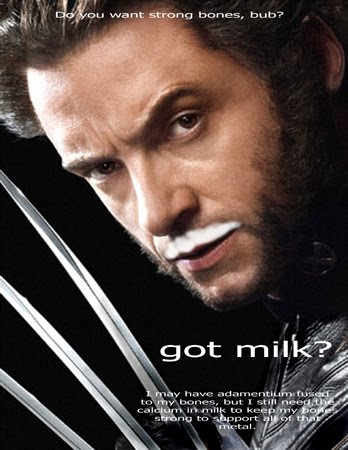
So the lesson here? Not all Marketing campaigns are just to increase brand awareness for potential customers, enticing them to become real customers. Sometimes the goal is to get existing customers to use our products more often.
Turn them into loyal customers, using the right marketing campaign to give them a reason why they should continue using your product.
7) Metro Trains: Dumb Ways to Die
Yeh, you read that right: “Dumb Ways to Die”
In Melbourne, Australia, Metro Trains conveys a simple message: Don’t play around the train tracks. There have been many tragic incidents, but instead of the usual danger signs at train stations, Metro Trains launched the Dumb Ways to Die campaign, a song from 2012 that has reached the present day. 163 million views on Youtube.
A song about silly ways to let yourself die — for example, by teasing a bear with a stick, or taking off your helmet in space. Combined with catchy tunes that are sure to make you laugh-“Dumb ways to die, so many dumb ways to die.”
At the end of the video, after you’ve seen some of the “funniest” ways to die of the cartoon characters, comes the main part of the message: There are many different stupid ways to die, but stupid ways to die. The dumbest thing would be if you stood close to the edge of the line while waiting for a train or trying to run across the tracks.
This creative campaign has become immensely popular for its ease of remembering, and you don’t feel like you’re being overly reminded in the usual way.
The lesson here: If your subject is a bit boring, try to incorporate creativity to successfully convey the message.
8) Apple: Get a Mac
Although there are many successful Apple campaigns, in my opinion, this one is the top of the top.
With the idea of a Mac versus a regular PC, the campaign was one of Apple’s best, and they instantly increased their market share to over 42% in the first year alone. first. This campaign shows viewers everything about Mac in the most impressive and smart way.
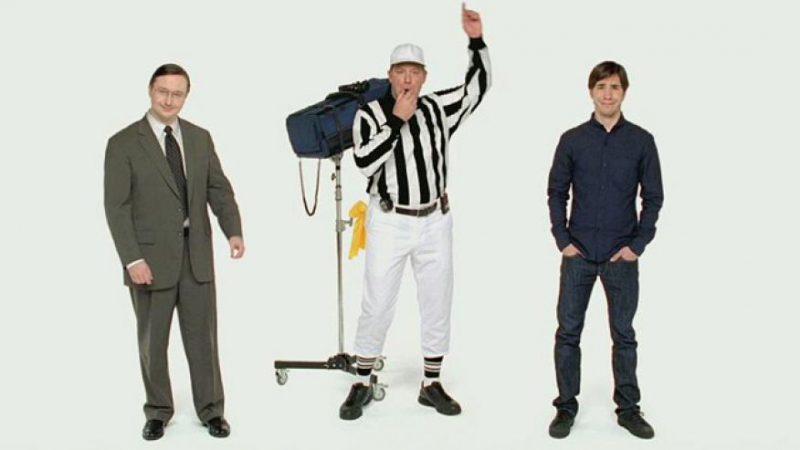
What do we learn? Don’t just because your product has a few cool things you will use those features to cram into the customer’s head. Instead, explain the benefits of the product in terms of how they imagine the context in which they use them.
9) Clairol: Does She or Doesn’t She?
When Clairol first asked this question in 1957, only 1 of 15 people dyed their hair. After 15 years, 1 in 2 people will have dyed hair, according to research by Time Magazine. The campaign was so successful that some states in the United States had to stop requiring women to fill out their driver’s license with the color of their hair.
Once your Marketing campaign changes the whole mechanism of a government agency, well, it is a big shock.
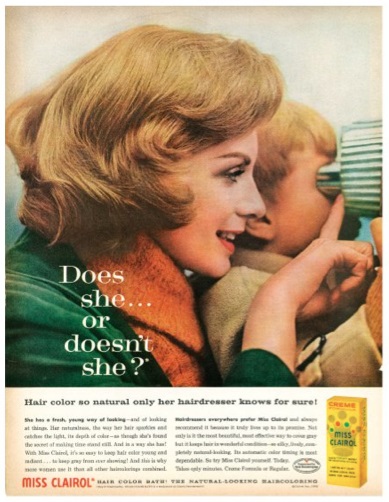
Clairol did the opposite of everyone else: They didn’t want every woman who met her friends to have to say that Clairol’s dye was good. They want every woman to understand that their dye is so good that it goes without saying.
The lesson here: Sometimes just showing the customer how good the product is and why is enough. It’s better to show them than to tell them.
10) De Beers: A Diamond is Forever
In 1999, Agency AdAge made De Beers’ slogan “A Diamond is Forever” the most famous saying of the 20th century. The campaign was based on the idea that no wedding would be complete without a wedding. Diamond ring. However, De Beers did not enter an existing market, they created a market for themselves, and turned diamond rings into a luxury product of the utmost necessity.
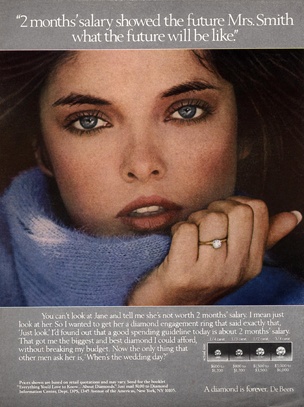
According to the New York Times, De Beers urges anyone getting married to feel compelled to have a diamond engagement ring.
Lesson here? Marketing can turn luxury products that few people buy into a must-have necessity.
11) Old Spice: The Man Your Man Could Smell Like
At the beginning of the Marketing Old Spice’s “The Man Your Man Could Smell Like” campaign, conceived by Wieden + Kennedy and running in February 2010, was just a regular advertisement. And it went viral after just 1 night:
This video has more than 51 million views, a few months later, in June 2010, Old Spice released a second advertisement with the same actor-Isaiah Mustafa. Mustafa quickly became the “Old Spice Guy,” a moniker the company used to reply to every comment on Facebook, Twitter, its website, and more.
2 days later, the company has filtered out, 186 responses of “Old Spice Guy” to customers, the best and funniest responses, to continue to put online, continue to go viral. And according to Inc., This video at that point has added 11 million views, Old Spice has 29,000 more followers on Facebook, and 58,000 followers on Twitter.
“No one thought at the time that asking questions would get a payoff.”
Lesson here? If your campaign is engaging on social media with your fans and followers, do all you can to prolong that engagement while still delivering the campaign’s message and message. personality of the message through images and tone of voice.
12) Wendy’s: Where’s the Beef?
The success of this marketing campaign just by combining a giant hamburger with a group of old people? No I do not think so
Wendy’s took a much smarter and more creative approach to its marketing: It positioned itself against Wendy’s. The phrase “Where’s my beef?” intended to imply that rival burgers are often too low in meat—and immediately caught the attention of viewers.

While it’s hard to tell if your tagline is catchy or not, Wendy’s (very cleverly) didn’t over-promote the tagline “Where’s the Beef?” This. This Marketing campaign only runs for exactly 1 year only.
The lesson here: Be careful with the success as well as the failure of your marketing campaign. Don’t just because you found this to be quite successful that you keep it running. Take the time to change and grow, do new things, and you will surely discover many more opportunities for future success.
13) Procter & Gamble: Thank You, Mom
I will give you a minute to wipe your tears after watching the video.
Seriously – It’s hard for you to imagine that a corporate promotional video for home consumer products could be so emotional?
Because P&G has told the stories behind the Olympic athletes-The stories of the mothers behind supporting and raising them. Of course, who will be using P&G products and doing all the housework?
Marketing lesson here: The emotional and family element in Marketing is always appreciated by customers in their purchasing decisions, so the more you have the great, mysterious story behind your product. , the more likely you are to tell it successfully.
14) Chick-fil-A: Eat Mor Chikin
Chick-fil-A ran this campaign in 1995, and to this day it drives some shoppers to double every time they see a picture of three cows sandwiched by two sandwiches.
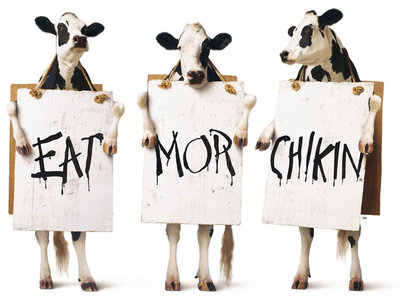
Good association has made this marketing campaign effective and successful. The image of cows fighting to get others to eat more chicken makes perfect sense, considering that Chick-fil-A is a chicken restaurant.
Try to use association in your next marketing campaign to approach the problem, and make them say curiously: “What’s the story behind this ad”.


